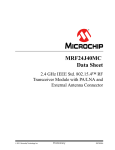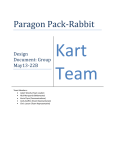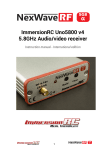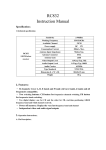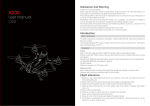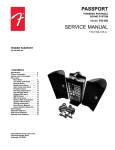Download Photon Datasheet (v011) Model number: PHOTONH void
Transcript
Photon Datasheet (v011)
Model number: PHOTONH
void setup() {
Spark.publish("my-event","The internet just got smarter!");
}
Functional description
Overview
Particle's Internet of Things hardware development kit, the Photon, provides everything you need to build a connected
product. Particle combines a powerful ARM Cortex M3 micro-controller with a Broadcom Wi-Fi chip in a tiny thumbnailsized module called the PØ (P-zero).
To get you started quickly, Particle adds a rock solid 3.3VDC SMPS power supply, RF and user interface components to
the PØ on a small single-sided PCB called the Photon. The design is open source, so when you're ready to integrate the
Photon into your product, you can.
The Photon comes in two physical forms: with headers and without. Prototyping is easy with headers as the Photon
plugs directly into standard breadboards and perfboards, and may also be mounted with 0.1" pitch female headers on a
PCB. To minimize space required, the Photon form factor without headers has castellated edges. These make it possible
to surface mount the Photon directly onto your PCB.
Features
Particle PØ Wi-Fi module
Broadcom BCM43362 Wi-Fi chip
802.11b/g/n Wi-Fi
STM32F205 120Mhz ARM Cortex M3
1MB flash, 128KB RAM
On-board RGB status LED (ext. drive provided)
18 Mixed-signal GPIO and advanced peripherals
Open source design
Real-time operating system (FreeRTOS)
Soft AP setup
FCC, CE and IC certified
Interfaces
Block Diagram
Power
Power to the Photon is supplied via the on-board USB Micro B connector or directly via the VIN pin. If power is supplied
directly to the VIN pin, the voltage should be regulated between 3.6VDC and 5.5VDC. When the Photon is powered via
the USB port, VIN will output a voltage of approximately 4.8VDC due to a reverse polarity protection series schottky
diode between V+ of USB and VIN. When used as an output, the max load on VIN is 1A.
Typical current consumption is 80mA with a 5V input. Deep sleep quiescent current is 160uA. When powering the
Photon from the USB connector, make sure to use a quality cable to minimize IR drops (current x resistance = voltage) in
the wiring. If a high resistance cable (i.e., low current) is used, peak currents drawn from the Photon when transmitting
and receiving will result in voltage sag at the input which may cause a system brown out or intermittent operation.
Likewise, the power source should be sufficient enough to source 1A of current to be on the safe side.
RF
The RF section of the Photon is a finely tuned impedance controlled network of components that optimize the efficiency
and sensitivity of the Wi-Fi communications.
An RF feed line runs from the PØ module into a SPDT RF-switch. Logic level control lines on the PØ module select which
of the two ports of the RF-switch is connected to the RF feed line. A 100pF decoupling capacitor is located on each
control line. One port is connected to a PCB ceramic chip antenna, and the other is connected to a u.FL connector for
external antenna adaptation. The default port will be set to the chip antenna.
Additionally, a user API is available to switch between internal, external and even an automatic mode which
continuously switches between each antenna and selects the best signal. All three RF ports on the RF-switch have a
10pF RF quality DC-blocking capacitor in series with them. These effectively pass 2.4GHz frequencies freely while
blocking unwanted DC voltages from damaging the RF-switch. All RF traces are considered as tiny transmission lines that
have a controlled 50 ohm impedance.
The chip antenna is impedance matched to the 50 ohm RF feed line via a Pi network comprised of three RF inductors (1
series, 2 shunt). These values are quite specific to the Photon due to the PCB construction and layout of the RF section.
Even if the Photon's layout design is copied exactly, to achieve the best performance it would be worth re-examining
the Pi network values on actual samples of the PCB in question.
FCC Approved Antennas
Antenna Type
Manufacturer
Dipole antenna LumenRadio
Chip antenna
MFG. Part #
Gain
104-1001
2.15dBi
Advanced Ceramic X AT7020-E3R0HBA 1.3dBi
Peripherals and GPIO
The Photon has ton of capability in a small footprint, with analog, digital and communication interfaces.
Peripheral Type Qty Input(I) / Output(O) FT[1] / 3V3[2]
Digital
18
I/O
FT/3V3
Analog (ADC)
8
I
3V3
Peripheral Type Qty Input(I) / Output(O) FT[1] / 3V3[2]
Analog (DAC)
2
O
3V3
SPI
2
I/O
3V3
I2S
1
I/O
3V3
I2C
1
I/O
FT
CAN
1
I/O
FT
USB
1
I/O
3V3
PWM
93
O
3V3
Notes:
[1] FT = 5.0V tolerant pins. All pins except A3 and DAC are 5V tolerant (when not in analog mode). If used as a 5V input
the pull-up/pull-down resistor must be disabled.
[2] 3V3 = 3.3V max pins.
[3] PWM is available on D0, D1, D2, D3, A4, A5, WKP, RX, TX with a caveat: PWM timer peripheral is duplicated on two
pins (A5/D2) and (A4/D3) for 7 total independent PWM outputs. For example: PWM may be used on A5 while D2 is used
as a GPIO, or D2 as a PWM while A5 is used as an analog input. However A5 and D2 cannot be used as independently
controlled PWM outputs at the same time.
JTAG
Pin D3 through D7 are JTAG interface pins. These can be used to reprogram your Photon bootloader or user firmware
image with standard JTAG tools such as the ST-Link v2, J-Link, R-Link, OLIMEX ARM-USB-TINI-H, and also the FTDI-based
Particle JTAG Programmer.
Photon Pin Description STM32 Pin PØ Pin # PØ Pin Name
Default Internal[1]
D7
JTAG_TMS
PA13
44
MICRO_JTAG_TMS
~40k pull-up
D6
JTAG_TCK
PA14
40
MICRO_JTAG_TCK
~40k pull-down
D5
JTAG_TDI
PA15
43
MICRO_JTAG_TDI
~40k pull-up
D4
JTAG_TDO
PB3
41
MICRO_JTAG_TDO
Floating
D3
JTAG_TRST
PB4
42
MICRO_JTAG_TRSTN ~40k pull-up
Photon Pin Description STM32 Pin PØ Pin # PØ Pin Name
3V3
Power
GND
Ground
RST
Reset
Default Internal[1]
Notes: [1] Default state after reset for a short period of time before these pins are restored to GPIO (if JTAG debugging
is not required, i.e. USE_SWD_JTAG=y is not specified on the command line.)
A standard 20-pin 0.1" shrouded male JTAG interface connector should be wired as follows:
External Coexistence Interface
The Photon supports coexistence with Bluetooth and other external radios via the three gold pads on the top side of the
PCB near pin A3. These pads are 0.035" square, spaced 0.049" apart. This spacing supports the possibility of tacking on a
small 1.25mm - 1.27mm pitch 3-pin male header to make it somewhat easier to interface with.
When two radios occupying the same frequency band are used in the same system, such as Wi-Fi and Bluetooth, a
coexistence interface can be used to coordinate transmit activity, to ensure optimal performance by arbitrating conflicts
between the two radios.
Pad # PØ Pin Name
PØ Pin # I/O Description
1
BTCX_RF_ACTIVE 9
I
Signals Bluetooth is active
2
BTCX_STATUS
10
I
Signals Bluetooth priority status and TX/RX direction
3
BTCX_TXCONF
11
O
Output giving Bluetooth permission to TX
When these pads are programmed to be used as a Bluetooth coexistence interface, they're set as high impedance on
power up and reset. Alternatively, they can be individually programmed to be used as GPIOs through software control.
They can also be programmed to have an internal pull-up or pull-down resistor.
Pin and button definition
Pin markings
Pin description
Pin
Description
VIN
This pin can be used as an input or output. As an input, supply 3.6 to 5.5VDC to power the Photon. When the
Photon is powered via the USB port, this pin will output a voltage of approximately 4.8VDC due to a reverse
polarity protection series schottky diode between VUSB and VIN. When used as an output, the max load on VIN
is 1A.
RST
Active-low reset input. On-board circuitry contains a 1k ohm pull-up resistor between RST and 3V3, and 0.1uF
Pin
Description
capacitor between RST and GND.
VBAT
Supply to the internal RTC, backup registers and SRAM when 3V3 is not present (1.65 to 3.6VDC).
3V3
This pin is the output of the on-board regulator and is internally connected to the VDD of the WiFi module.
When powering the Photon via VIN or the USB port, this pin will output a voltage of 3.3VDC. This pin can also
be used to power the Photon directly (max input 3.3VDC). When used as an output, the max load on 3V3 is
100mA. NOTE: When powering the Photon via this pin, ensure power is disconnected from VIN and USB.
WKP
Active-high wakeup pin, wakes the module from sleep/standby modes. When not used as a WAKEUP, this pin
can also be used as a digital GPIO, ADC input or PWM.
D0~D7 Digital only GPIO pins.
A0~A7 12-bit Analog-to-Digital (A/D) inputs (0-4095), and also digital GPIOs. A6 and A7 are code convenience
mappings, which means pins are not actually labeled as such but you may use code like analogRead(A7). A6
maps to the DAC pin and A7 maps to the WKP pin.
DAC
12-bit Digital-to-Analog (D/A) output (0-4095), and also a digital GPIO. DAC is used as DAC or DAC1 in software,
and A3 is a second DAC output used as DAC2 in software.
RX
Primarily used as UART RX, but can also be used as a digital GPIO or PWM.
TX
Primarily used as UART TX, but can also be used as a digital GPIO or PWM.
Pin out diagrams
<="">
<="">
<="">
Technical specification
Absolute maximum ratings
Parameter
Symbol
Supply Input Voltage
VIN-MAX
+6.5
V
Supply Output Current
IIN-MAX-L
1
A
Supply Output Current
I3V3-MAX-L
100
mA
Storage Temperature
Tstg
+85
°C
Enable Voltage
VEN
ESD Susceptibility HBM (Human Body Mode) VESD
Recommended operating conditions
Min Typ Max
-40
Unit
VIN+0.6 V
2
kV
Parameter
Symbol Min
Supply Input Voltage
VIN
Supply Input Voltage
V3V3
Supply Output Voltage
Max
Unit
+3.6
+5.5
V
+3.0
+3.3 +3.6
V
VIN
+4.8
V
Supply Output Voltage
V3V3
+3.3
V
Supply Input Voltage
VVBAT
Supply Input Current (VBAT)
IVBAT
Operating Current (Wi-Fi on)
IIN avg
Operating Current (Wi-Fi on)
IIN pk
Operating Current (Wi-Fi on, w/powersave)
IIN avg
18
100[2] mA
Operating Current (Wi-Fi off)
IIN avg
30
40
mA
Sleep Current (5V @ VIN)
IQs
1
2
mA
Deep Sleep Current (5V @ VIN)
IQds
80
100
uA
Operating Temperature
Top
+60
°C
95
%
Humidity Range Non condensing, relative humidity
Typ
+1.65
80
235[1]
-20
+3.6
V
19
uA
100
mA
430[1] mA
Notes:
[1] These numbers represent the extreme range of short peak current bursts when transmitting and receiving in
802.11b/g/n modes at different power levels. Average TX current consumption in will be 80-100mA.
[2] These are very short average current bursts when transmitting and receiving. On average if minimizing frequency of
TX/RX events, current consumption in powersave mode will be 18mA
Wi-Fi Specifications
Feature
Description
WLAN Standards IEEE 802 11b/g/n
Feature
Description
Antenna Port
Single Antenna
Frequency Band
2.412GHz -- 2.462GHz (United States of America and Canada)
2.412GHz -- 2.472GHz (EU)
Sub Channels
1 -- 11 (United States of America and Canada)
1 -- 13 (EU)
Modulation
DSSS, CCK, OFDM, BPSK, QPSK, 16QAM, 64QAM
PØ module Wi-Fi output power
Typ.
RF Average Output Power, 802.11b CCK Mode
Tol.
Unit
1M
Avail. upon request +/- 1.5 dBm
11M
-
+/- 1.5 dBm
-
+/- 1.5 dBm
-
+/- 1.5 dBm
RF Average Output Power, 802.11n OFDM Mode MCS0 -
+/- 1.5 dBm
MCS7 -
+/- 1.5 dBm
RF Average Output Power, 802.11g OFDM Mode 6M
54M
I/O Characteristics
These specifications are based on the STM32F205RG datasheet, with reference to Photon pin nomenclature.
Parameter
Symbol Conditions
Min
Typ Max
Unit
Standard I/O input low level voltage
VIL
-0.3
0.28*(V3V32)+0.8
V
I/O FT[1] input low level voltage
VIL
-0.3
0.32*(V3V32)+0.75
V
Standard I/O input high level voltage
VIH
0.41*(V3V32)+1.3
V3V3+0.3
V
Parameter
Symbol Conditions
Min
Typ Max
Unit
I/O FT[1] input high level voltage
VIH
V3V3 > 2V
0.42*(V3V32)+1
5.5
V
VIH
V3V3 ≤ 2V
0.42*(V3V32)+1
5.2
V
Standard I/O Schmitt trigger voltage
hysteresis[2]
Vhys
200
mV
I/O FT Schmitt trigger voltage
hysteresis[2]
Vhys
5% V3V3[3]
mV
Input leakage current[4]
Ilkg
GND ≤ Vio ≤ V3V3
GPIOs
Input leakage current[4]
Ilkg
RPU
Vio = 5V, I/O FT
Weak pull-up equivalent resistor[5]
RPU
Vio = GND
30
Weak pull-down equivalent
resistor[5]
RPD
Vio = V3V3
30
I/O pin capacitance
CIO
±1
µA
3
µA
40
50
kΩ
40
50
kΩ
5
pF
Notes:
[1] FT = Five-volt tolerant. In order to sustain a voltage higher than V3V3+0.3 the internal pull-up/pull-down resistors
must be disabled.
[2] Hysteresis voltage between Schmitt trigger switching levels. Based on characterization, not tested in production.
[3] With a minimum of 100mV.
[4] Leakage could be higher than max. if negative current is injected on adjacent pins.
[5] Pull-up and pull-down resistors are designed with a true resistance in series with switchable PMOS/NMOS. This
PMOS/NMOS contribution to the series resistance is minimum (~10% order).
Mechanical specifications
Dimensions and Weight
Headers Dimensions in inches (mm)
With
Weight
1.44 x 0.8 x 0.27 (36.58 x 20.32 x 6.86) 5 grams
Headers Dimensions in inches (mm)
Weight
Without 1.44 x 0.8 x 0.17 (36.58 x 20.32 x 4.32) 3.7 grams
Mating connectors
The Photon (with headers) can be mounted with (qty 2) 12-pin single row 0.1" female headers. Typically these are
0.335" (8.5mm) tall, but you may pick a taller one if desired. When you search for parts like these it can be difficult to
navigate the thousands of parts available.
On Digikey.com, this section Rectangular Connectors - Headers, Receptacles, Female Sockets contains 36,000 of them.
Narrow the search with: 12 positions, 1 row, 0.1" (2.54mm) pitch, Through Hole mounting types (unless you want SMT),
and sort by Price Ascending. You may find something like this:
Description
MFG
MFG Part Number
12-pin 0.1" Female Header (Tin)
Sullins Connector Solutions PPTC121LFBN-RC
12-pin 0.1" Female Header (Gold) Sullins Connector Solutions PPPC121LFBN-RC
You may also search for other types, such as reverse mounted (bottom side SMT) female headers, low profile types,
machine pin, etc..
Recommended pcb land pattern (Photon with headers)
The Photon (with headers) can be mounted with 0.1" 12-pin female header receptacles using the following PCB land
pattern:
This land pattern can be found in the Spark.lbr Eagle library, as a Device named PHOTON. Note: Clone or Download the
complete repository as a ZIP file to avoid corrupted data in Eagle files.
Recommended pcb land pattern (Photon without headers)
The Photon (without headers) can be surface mounted directly in an end application PCB using the following PCB land
pattern:
Photon Pin #25-31 are described in the Pin Out Diagrams.
Photon Pin #25-31 are described in the Pin Out Diagrams.
Solder mask around exposed copper pads should be 0.1mm (4 mils) larger in all directions. E.g., a 0.08" x 0.10" pad
would have a 0.088" x 0.108" solder mask.
This land pattern can be found in the Spark.lbr Eagle library, as a Device named PHOTON_SMD. Note: Clone or
Download the complete repository as a ZIP file to avoid corrupted data in Eagle files.
Schematic
Schematic - USB
Schematic - Power
Schematic - User I/O
Schematic - RF
Schematic - PØ Wi-Fi Module
Layout
Photon v1.0.0 Top Layer (GTL)
Photon v1.0.0 GND Layer (G2L)
Photon v1.0.0 3V3 Layer (G15L)
Photon v1.0.0 Bottom Layer (GBL)
Recommended solder reflow profile
Phase Temperatures and Rates
A-B.
Ambient~150°C, Heating rate: < 3°C/s
B-C.
150~200°C, soak time: 60~120 s
C-D.
200~245°C, Heating rate: < 3°C/s
D.
Peak temp.: 235~245°C, Time above 220°C: 40~90 s
D-E.
245~220°C, Cooling rate: < 1°C/s
Bill of Materials
Build your own design based on the Photon!
Qty Device
Minimum
Specification
1
ANTENNA
2
Package/Case
Part Designator
MFG.
MFG. PN
2.4GHz Ceramic
5.0mm ×
2.0mm x
2.6mm
ANT1
Advanced
Ceramic X
AT7020-E3R0HBA
CERAMIC
CAPACITOR
22uF Ceramic
6.3V 10% X5R
0603
C4,C5
Samsung
CL10A226MQ8NRNC
6
CERAMIC
CAPACITOR
0.1uF Ceramic
6.3V 10% X5R
0402
C6,C7,C8,C11,C12,C16 RongFu
0402B104K01A
2
CERAMIC
CAPACITOR
100pF Ceramic
6.3V 10% X5R
0402
C2,C3
Fenghua
0402CG101J500NT
4
CERAMIC
CAPACITOR
10uF Ceramic
6.3V 10% X5R
0603
C9,C11,C13,C15
Sumsung
CL10A106MQ8NNNC
3
CERAMIC
CAPACITOR
(RF)
10pF Ceramic
6.3V 10% X5R
0402
C1,C14,C17
Murata
GJM1555C1HR80BB01D
1
CONNECTOR
USB Micro-B
w/tabs & slots
USB-MICROB
X1
Kaweei
CMCUSB-5BFM2G-01-D
1
CONNECTOR
uFL Connector
SMD
X2
Kaweei
P1163-0140R
2
HEADER
Single String 1.2"
Mating Length
0.1" 12-pin
JP1,JP2
Kaweei
CP25411-12G-S116-A
1
DIODE
Diode Schottky
30V 3A
DO-220AA
D1
Vishay
SS3P3-M3/84A
1
DIODE (LED)
Blue
SMD 0603
LED1
Everlight
19-217/BHCZL1M2RY/3T
1
DIODE (LED)
LED RGB
Common Anode
Diffused SMD
4-PLCC
(2.0mm x
2.0mm)
LED2
Cree
CLMVB-FKACFHEHLCBB7A363
1
INDUCTOR
2.2uH 1.5A
3mm x 3mm
L4
Taiyo
Yuden
NR3015T2R2M
Qty Device
Minimum
Specification
Package/Case
Part Designator
MFG.
MFG. PN
1
INDUCTOR
(RF)
3.9nH RF
inductor
0402
L3
Johanson
L-07C3N9SV6T
1
INDUCTOR
(RF)
4.7nH RF
inductor
0402
L1
Johanson
L-07C4N7SV6T
1
INDUCTOR
(RF)
6.8nH RF
inductor
0402
L2
Johanson
L-07C6N8JV6T
1
WI-FI + MCU
Broadcom Wi-FI
+ STM32 MCU
Custom USI
SMD
U1
USI
WM-N-BM-09-S
1
RF SWITCH
RF Switch SPDT
UQFN-6
(1x1mm)
U3
Skyworks
SKY13350-385LF
1
POWER
REGULATOR
3.3V 1.5MHz
600mA High
Efficiency PWM
Step-Down
DC/DC Converter
SOT23-5
U2
Richtek
RT8008-33GB
1
RESISTOR
100k 5%
0402
R4
Fenghua
RC-02W104FT
2
RESISTOR
22R 5%
0402
R5,R6
Fenghua
RC-02W220JT
1
RESISTOR
10k 5%
0402
R8
Fenghua
RC-02W103JT
4
RESISTOR
1k 5%
0402
R1,R2,R3,R7
Fenghua
RC-02W102JT
2
SWITCH
Button 160gf
3.6mm x
3.1mm
SETUP,RESET
Haoyu
TS-1185A-C
Ordering information
Photons are available from store.particle.io in single quantities with and without headers, and also included in different
maker kits.
Qualification and approvals
Model number: PHOTONH
RoHS
CE
FCC ID: 2AEMI-PHOTON
IC: 20127-PHOTON
Product handling
Packaging
The Photon comes in two primary styles of packaging: Matchbox and Kit Box. The Matchbox contains the bare essentials
to get you started, while the kit box contains a breadboard, Micro B USB cable, sticker, prototyping card and a couple
sensors to build your first internet connected project!
Photons without headers are also available in JEDEC style trays for automated pick and place machines. Request more
details from us on this in the Contact section below.
Moisture sensitivity levels
The Moisture Sensitivity Level (MSL) relates to the packaging and handling precautions required. The PØ module on the
Photons dominate the MSL requirements and are rated level 3. In general, this precaution applies for Photons without
headers. If reflowing a Photon directly onto an application PCB, increased moisture levels prior to reflow can damage
sensitive electronics on the Photon. A bake process to reduce moisture may be required.
For more information regarding moisture sensitivity levels, labeling, storage and drying see the MSL standard see
IPC/JEDEC J-STD-020 (can be downloaded from www.jedec.org).
ESD Precautions
The photon contains highly sensitive electronic circuitry and is an Electrostatic Sensitive Device (ESD). Handling a photon
without proper ESD protection may destroy or damage it permanently. Proper ESD handling and packaging procedures
must be applied throughout the processing, handling and operation of any application that incorporates photons. ESD
precautions should be implemented on the application board where the photon is mounted. Failure to observe these
precautions can result in severe damage to the photon!
Default settings
The Photon comes preprogrammed with a bootloader and a user application called Tinker. This application works with
an iOS and Android app also named Tinker that allows you to very easily toggle digital pins, take analog and digital
readings and drive variable PWM outputs.
The bootloader allows you to easily update the user application via several different methods, USB, OTA, Serial YModem, and also internally via the Factory Reset procedure. All of these methods have multiple tools associated with
them as well.
You may use the online Web IDE Particle Build to code, compile and flash a user application OTA (Over The Air). Particle
Dev is a local tool that uses the Cloud to compile and flash OTA as well. There is also a package Spark DFU-UTIL for
Particle Dev that allows for Cloud compiling and local flashing via DFU over USB. This requires dfu-util to be installed on
your system. 'dfu-util' can also be used with Particle CLI for Cloud compiling and local flashing via the command line.
Finally the lowest level of development is available via the GNU GCC toolchain for ARM, which offers local compile and
flash via dfu-util. This gives the user complete control of all source code and flashing methods. This is an extensive list,
however not exhaustive.
Glossary
SMPS
Switched-Mode Power Supply
RF
Radio Frequency
Castellated
The edge of the PCB has plated holes that are cut in half which resemble the top of a castle. These make it easy to solder
the Photon down to another PCB with a SMT reflow process.
SMT
Surface Mount Technology (often associated with SMD which is a surface mount device).
AP
Access Point
LED
Light-Emitting Diode
RGB LED
Red green and blue LEDs combined and diffused in one package.
USB
Universal Serial Bus
Quiescent current
Current consumed in the deepest sleep state
FT
Five-tolerant; Refers to a pin being tolerant to 5V.
3V3
+3.3V; The regulated +3.3V supply rail. Also used to note a pin is only 3.3V tolerant.
RTC
Real Time Clock
OTA
Over The Air; describing how firmware is transferred to the device.
FCC IC CE Warnings and End Product Labeling Requirements
Federal Communication Commission Interference Statement This equipment has been tested and found to comply with
the limits for a Class B digital device, pursuant to Part 15 of the FCC Rules. These limits are designed to provide
reasonable protection against harmful interference in a residential installation. This equipment generates, uses and can
radiate radio frequency energy and, if not installed and used in accordance with the instructions, may cause harmful
interference to radio communications. However, there is no guarantee that interference will not occur in a particular
installation. If this equipment does cause harmful interference to radio or television reception, which can be determined
by turning the equipment off and on, the user is encouraged to try to correct the interference by one of the following
measures:
Reorient or relocate the receiving antenna.
Increase the separation between the equipment and receiver.
Connect the equipment into an outlet on a circuit different from that to which the receiver is connected.
Consult the dealer or an experienced radio/TV technician for help.
FCC Caution: Any changes or modifications not expressly approved by the party responsible for compliance could void
the user's authority to operate this equipment. This device complies with Part 15 of the FCC Rules. Operation is subject
to the following two conditions:
This device may not cause harmful interference, and
This device must accept any interference received, including interference that may cause undesired operation.
FCC Radiation Exposure Statement: This equipment complies with FCC radiation exposure limits set forth for an
uncontrolled environment. This transmitter module must not be co-located or operating in conjunction with any other
antenna or transmitter. This End equipment should be installed and operated with a minimum distance of 20
centimeters between the radiator and your body.
IMPORTANT NOTE: In the event that these conditions can not be met (for example certain laptop configurations or colocation with another transmitter), then the FCC authorization is no longer considered valid and the FCC ID can not be
used on the final product. In these circumstances, the OEM integrator will be responsible for re-evaluating the end
product (including the transmitter) and obtaining a separate FCC authorization.
End Product Labeling The final end product must be labeled in a visible area with the following:
Contains FCC ID: 2AEMI-PHOTON
Manual Information to the End User The OEM integrator has to be aware not to provide information to the end user
regarding how to install or remove this RF module in the user’s manual of the end product which integrates this module.
Canada Statement This device complies with Industry Canada’s licence-exempt RSSs. Operation is subject to the
following two conditions:
This device may not cause interference; and
This device must accept any interference, including interference that may cause undesired operation of the device.
Le présent appareil est conforme aux CNR d’Industrie Canada applicables aux appareils radio exempts de licence.
L’exploitation est autorisée aux deux conditions suivantes:
l’appareil ne doit pas produire de brouillage;
l’utilisateur de l’appareil doit accepter tout brouillage radioélectrique subi, même si le brouillage est susceptible d’en
compromettre le fonctionnement.
Caution Exposure: This device meets the exemption from the routine evaluation limits in section 2.5 of RSS102 and
users can obtain Canadian information on RF exposure and compliance. Le dispositif répond à l'exemption des limites
d'évaluation de routine dans la section 2.5 de RSS102 et les utilisateurs peuvent obtenir des renseignements canadiens
sur l'exposition aux RF et le respect.
The final end product must be labelled in a visible area with the following: The Industry Canada certification label of a
module shall be clearly visible at all times when installed in the host device, otherwise the host device must be labelled
to display the Industry Canada certification number of the module, preceded by the words “Contains transmitter
module”, or the word “Contains”, or similar wording expressing the same meaning, as follows:
Contains transmitter module IC: 20127-PHOTON
This End equipment should be installed and operated with a minimum distance of 20 centimeters between the radiator
and your body. Cet équipement devrait être installé et actionné avec une distance minimum de 20 centimètres entre le
radiateur et votre corps.
The end user manual shall include all required regulatory information/warning as shown in this manual.

























